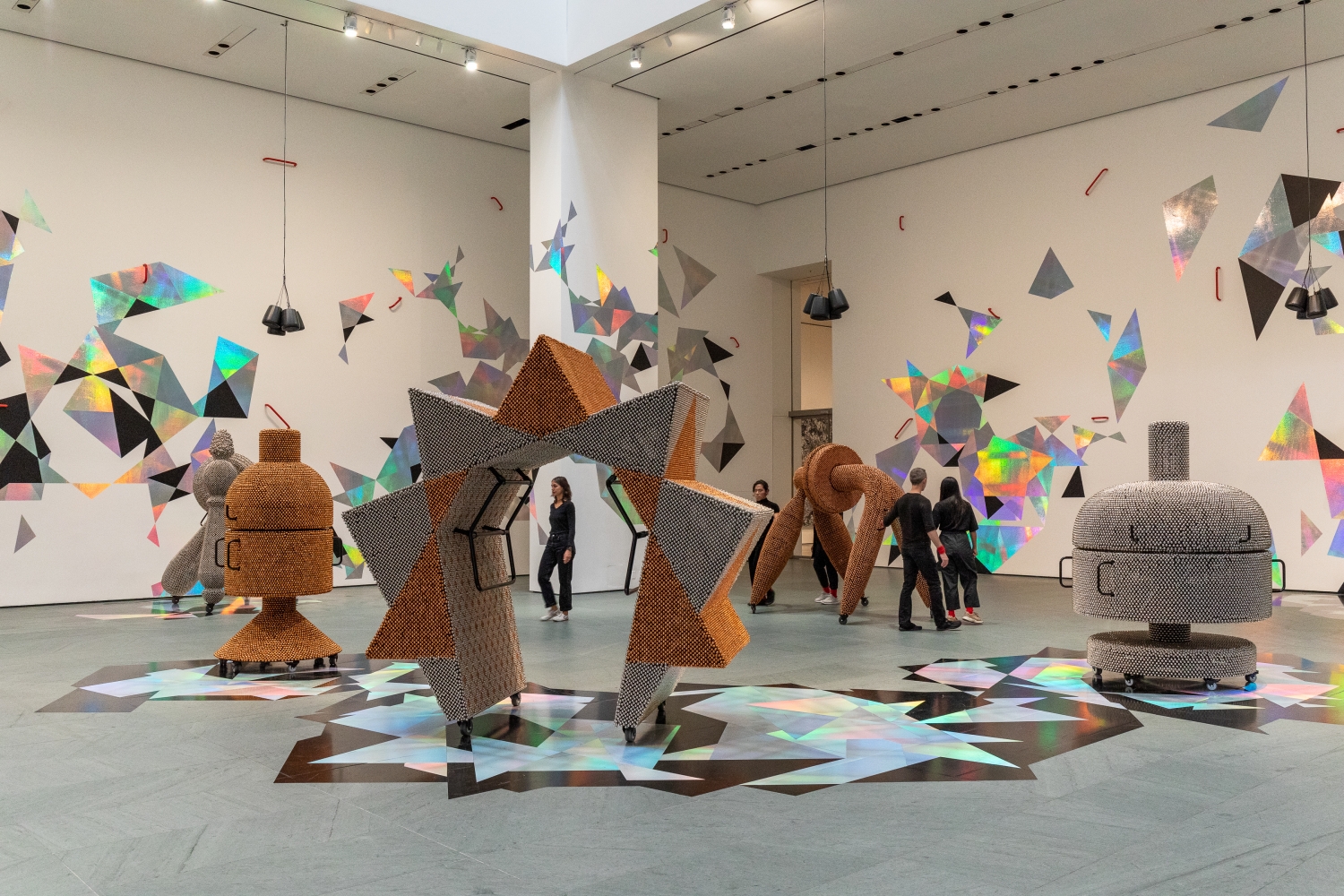News
October 2019
Haegue Yang Presents New Monumental Installation at Solo Exhibition titled Haegue Yang: Handles in Celebration of the Re-Opening of the Museum of Modern Art, New York
Exhibition Dates: Oct 21, 2019 – Apr 12, 2020
Exhibition Venue: MoMA (미국 뉴욕 현대미술관)
Website: www.moma.org/calendar/exhibitions/5080
Haegue Yang is the subject of a solo exhibition titled Haegue Yang: Handles in the Marron Atrium at The Museum of Modern Art (hereafter MoMA) through April 12, 2020. For the opening of the museum’s expanded campus on October 21, 2019, MoMA had commissioned an installation by Yang for the Marron Atrium, the biggest exhibition space within MoMA. Haegue Yang: Handles features six dynamic sculptures, wall designs based on dazzling geometries, and the play of light and sound to create a complex environment.
As handles are points of attachment and material catalysts for movement and change, Yang considers this everyday interface between people and things. The red steel grab bars are mounted on the walls amid the dazzling hologram and the iridescent pattern of a panoramic collage. While the bars on the walls don’t work as handles, the handles attached to the six sculptures can be put to functional use, moving the works about within the space. Covered in skins of bells, these monumental works come in distinctive shapes: two of the sculptures are inspired by the work of the Swiss painter, dancer, architect, and educator Sophie Taeuber-Arp’s small sculptures titled Coupe Dada, another sculpture refers to the enneagram of the mystic philosopher G. I. Gurdjieff, and the three remaining sculptures use open-source designs for door handles. Mounted on casters, the sculptures generate a subtle rattling sound when maneuvered by performers at regular intervals, and recall the use of bells in shamanistic rites, among other sources, while the haptic and auditory qualities of Yang’s Sonic Sculptures animate their imposing physicality. The chorus of bells also suggests ideas of resonance, championing more diverse social and political models while the patterns of movement in the installation echo Yang’s ongoing investigation into concerns of migration.
Stuart Comer, The Lonti Ebers Chief Curator of Media and Performance, explains, “Haegue Yang has built a distinguished career on her singular ability to synthesize a rich array of cultural references across time periods and geographies into sculptural and sensorial installations. Her ambitious commission for MoMA presents an immersive, prismatic environment through which a diverse set of histories and forms is transformed into an exciting new vocabulary of mobile sonic sculptures that animate the space as much as they do a more open notion of history.”
‘손잡이’는 이동과 변화를 위한 물리적 촉매제이자 접촉점으로, 양혜규는 사람과 사물 간의 일상적 접점에 주목했다. 수십여 개의 붉은색 강철 손잡이가 전시장 삼면의 벽에 걸쳐 빛을 분산시키는 홀로그램과 검정 스티커로 콜라주 된 대형 벽화와 함께 자체적인 무늬를 이룬다. 벽에 설치된 손잡이는 기능하지 않는데 반해, 조각물에 부착된 손잡이는 각기 독특한 형태를 띤 여섯 점의 구조물을 실질적으로 움직이게 한다. 이 몸체 표면 전체가 방울로 뒤덮인 6점의 구조물은 스위스 출신의 여성 미술작가이자 무용가, 건축가, 교육자였던 소피 토이버-아르프(Sophie Taeuber-Arp)의 ‘쿱 다다(Coupe Dada)’라는 소형 조각물을 참조한 조각 2 점과 신비주의 철학자 게오르기 이바노비치 구르지예프(G. I. Gurdjieff)의 에니어그램(Enneagram) 등을 참조한 조각 1 점, 그리고 오픈소스 손잡이 디자인을 활용한 조각 3점으로 구성된다. 바퀴가 달려 움직임이 가능한 이 조각물들은 퍼포머에 의해 활성화되면서 은은한 방울 소리를 내는데, 이렇게 조각의 인상적인 물성에 첨가된 촉각적, 청각적 요소들은 작품 및 공간 전체에 생기를 불어넣으며 일종의 주술 의식을 연상시킨다. 작품의 움직임에 따른 공명을 암시하는 방울의 합창은 이주와 디아스포라 등의 혼성적 사회·정치적 모델에 대한 작가 양혜규의 오랜 탐구를 반영한다.
“양혜규는 시공간을 넘나드는 풍부한 문화적 참조를 조각적이고 감각적인 설치작업으로 통합해내는 탁월한 능력이 있다. 이번 모마 전시작은 몰입도를 끌어올린 환경을 조성해 다양한 문화적 역사를 ‘소리 나는 이동식 조각’이라는 새로운 형태-언어로 번안해 미술관 공간에 생기를 불어넣을 뿐 아니라 보다 열린 역사관을 창출한다.” – 《양혜규: 손잡이》전 큐레이터 스튜어트 코머(Stuart Comer)
[Source from the MoMA, Kukje Gallery press release]



